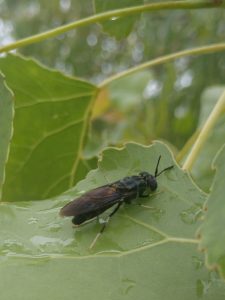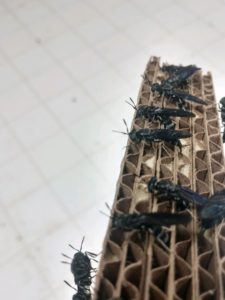Zero waste: Maggots as recyclers and protein sources
Texas A&M professor invents technology to harness black soldier flies for waste removal, protein for animals

COLLEGE STATION — Black soldier fly maggots provide a zero waste option for organic recycling, according to Jeff Tomberlin, Ph.D., professor in the department of entomology at Texas A&M University and director of EVO Conversion Systems, LLC.
Despite the “ick-factor,” maggots can be helpful for the environment by reducing waste and serving as an animal feed source, he said.
The larval form of the black soldier fly eats profusely during this stage of development. The maggots essentially climb on top of each other, wriggling and writhing in an effort to get to the food source or waste material. The larvae eat until they are full, and as they take a breather from their snack, other larvae push in to snag a bite to eat, shifting the others up and out of the way, creating a tower of maggots.
It may sound gross, but it reduces decomposition time for compost by months, Tomberlin explained.
At the end of the 14-day cycle, the tower of larvae is dried. These dried larvae become feed for animals that humans then consume. The most common example is as a protein source for chickens.
The larvae can also be processed to isolate the protein, which can then become part of a feed for livestock, poultry and fish. The maggot waste can also be used as compost for landscaping. Essentially, it’s the natural life-cycle power of the black soldier fly but harnessed by humans.
It’s been very successful in China, Europe and other parts of the world, and the process is now being utilized for profit here in Texas.
BULLET TECHNOLOGY
Tomberlin and his team have come up with a more efficient way to harness the process of waste reduction with a new technology he calls the Black Soldier Fly Bullet. The Bullet provides storage of the larvae for an extended period of time, giving the human users the ability to “wake them up” whenever the need arises by opening the container and placing them on the waste material.
“Drs. Tomberlin, Cammack and Mr. Yang, all from Texas A&M AgriLife Research, invented a new technology to greatly increase the efficiency of black soldier fly, or BSF, conversion of waste material,” said Robert Brummett, AgriLife Research licensing manager, College Station. “This technology, called the Black Soldier Fly Bullet, also facilitates storage and shipment of BSF, thus creating more stability and assurances in processes utilizing BSF larvae.”
Texas A&M AgriLife Intellectual Property and Commercialization worked with Dr. Tomberlin to exclusively license this AgriLife technology created by Tomberlin to his company, EVO Conversion Systems, LLC.
“Through EVO, he and his co-inventors can take the results of their research from the lab to real-world application and use,” Brummett said.
Tomberlin said this gave the company, which manages organic waste with black soldier fly larvae then uses the insect biomass as a sustainable animal feed ingredient and crop fertilizer, an opportunity to create zero waste on a larger scale.
“We were able to develop a system to put them in a state of stasis,” said Dr. Jonathan Cammack, chief operating officer of EVO Conversion Systems and former AgriLife Research postdoctoral research associate. “We are taking newly hatched larvae and putting them in an optimal environment to develop to a certain point, then sit and hang out until ready to be used.”
Tomberlin explained data supports that they can hold the larvae at an optimal temperature, potentially up to five months.
“The larval development time is 14 days, and we can do it in 6-7 days,” he said.
The larvae can then be placed on to the material, regardless of what the waste is, and in six to seven days, they have matured, Cammack explained. The larvae can then be harvested and dried, and the biomass has been converted from waste to insect protein in half the time.
“Basically, this technology puts them into hibernation for long-term storage, and when ready to use them, you wake them up and put them to work,” Tomberlin said.
RESPECT FOR SUSTAINABILITY
Growing up in Georgia, Tomberlin was taught the importance of family, agriculture and sustainability at a very young age. His grandmother, the matriarch of the family, shared with him the importance of taking care of the things you own and the resources available. This life lesson has stayed with Tomberlin and is reflected in his work with the black soldier fly and his dedication to finding ways to most effectively utilize food waste.
During his undergraduate career at the University of Georgia, Tomberlin was introduced to the black soldier fly through his Ph.D. advisor. The insect was not being widely studied at the time, but through Tomberlin’s research, has been widely adopted and is now being used around the world.
FROM MAGGOTS TO PROTEIN SOURCE

Tomberlin explained the adult black soldier fly, which looks similar to a wasp but without the stinger, will live for about two weeks. In general, the female will mate once and lay one batch of eggs. Those eggs hatch in about four days, and the larvae will feed for two weeks. This leaves about 18 days in the development aspect and about another two weeks in the pupal stage before the adult emerges.
“The lab at Texas A&M is a leading lab in the world on this topic,” Tomberlin said. “The first thing we did was develop a method to mass produce this insect in a colony. That method is now being employed in every major black soldier fly production facility in the world.”
As other countries employ these systems, they often first come to Tomberlin’s lab at Texas A&M to learn about the research, then go to the factory to learn about the industrial side of things.
“Most groups around the world are focused on that 14-day development that they can feed waste to it, recycle it and produce protein,” he said. “Through our research at Texas A&M, we have been able to enhance that system.
Cammack explained that they wanted to put some stability into the system, so the team looked at how much waste material a colony needed in order to flourish without having too much material for the colony, or too little. This balance would help to maximize the number of eggs that the colony would produce.
“If they lay a whole bunch of eggs and you don’t have enough material for them to digest or process, then you are losing eggs, and if you don’t have enough eggs and you have a whole bunch of waste available, then you have waste that rots,” Cammack said. “One is driving the other.”
PARTNERING UP FOR ZERO WASTE
With zero waste being the ultimate goal, the team has implemented a circular economy by working with Blackwater Draw Brewing Company, Rio Brazos Distillery and Cosmic Landscapes of Texas.
“We get the byproducts from the distillery and brewery and convert them to protein, and the compost that we then produce, or digestate, goes to the landscape company, and they use it for landscaping,” Tomberlin said. “So it is zero waste. That is what we are developing here in College Station and Bryan. There should be no food waste going into the landfill. It should be recycled to products of value.”
ZERO WASTE FACILITIES
“Our goal is to build a facility here and make College Station and Bryan a zero waste area,” he said. “If we can build a facility like that, it is not just a facility for recycling waste, it is a teaching facility. If we can build it in conjunction with A&M, we are talking about a facility where research can take place and students can be trained, and at the same time we are taking care of the community. We are creating jobs. That’s what we would like to see happen.”
Tomberlin sees success in this industry through the building of small to mid-sized industry sites, producing a facility with as little as $250,000. Creating these smaller facilities and placing them throughout rural America is the goal and will create jobs, protect the environment and produce a valued resource.
“We are looking to expand who we get our material from here in Bryan-College Station, but at the same time we want to talk with our local waste management companies,” Tomberlin said. “We don’t want to encroach on them, we want to help them. If there are things that we can divert from that waste that can go into our compost facility, we will work with them. We don’t see that as competition; we see it as collaboration.”


